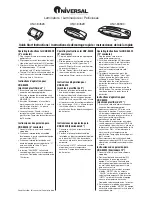
15
ACTION:
Loosen tension on side (top or bottom) film is curling toward.
PROBLEM:
Laminated item is wrinkled
ACTION:
Increase mandrel tension on the side (top or bottom) that has the wrinkles. May
need to reduce temperature. Make sure your paper is stored in a dry place.
PROBLEM:
Laminated item is blistered
ACTION:
Reduce temperature
PROBLEM:
Mandrel tension does not remain constant.
ACTION:
Tighten brake screw, it might be improperly adjusted. Rotate film core while
holding mandrel film. Core gripper blade may not be preventing the core from
spinning on the mandrel. Ensure mandrels are installed correctly (see page 6).
PROBLEM:
Laminator heats but motor does not turn on
ACTION:
Ensure motor is on and in forward position with speed turned on. Replace
motor fuse.
PROBLEM:
Laminator blows fuses often.
ACTION:
Ensure machine is running on a dedicated circuit. Do not exceed maximum
material thickness. Reduce supply mandrel tension.
Do’s and Don’ts...
•
Read the instruction manual before operating your laminator.
•
Always run test samples before laminating valuable items.
•
Feed the print through slowly and evenly, smoothing it as it is pulled into the
•
laminator.
•
Operate the laminator with two rolls of the same width laminating film to avoid
excessive adhesive transfer to the rollers.
•
If laminator is not in current use turn unit off.
•
Never feed abrasive materials or metal objects such as staples, paper clips, or
glitter through the laminator. Keep sharp objects like scissors and rulers away from
the rollers at all times.
•
Once an item has been fed between the rollers do not attempt to alter its position
as this can damage the print.
•
Do not stop the laminator before the item has completely exited from the rear to
avoid a “dwell line” across the print.
•
Do not clean or service the laminator before disconnecting the power supply.





























